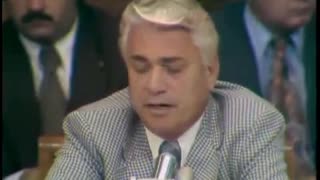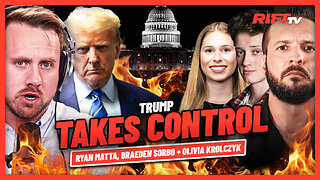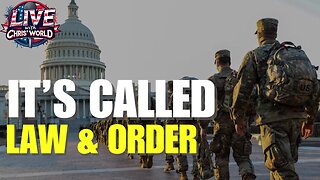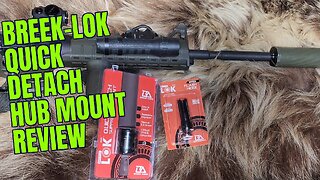Premium Only Content

The Disturbing World of a CIA Case Officer: Covert Action, Coups & Disinformation
More on John Stockwell and the Phoenix Program: https://thememoryhole.substack.com/
The Phoenix Program (Vietnamese: Chiến dịch Phụng Hoàng) was designed and initially coordinated by the United States Central Intelligence Agency (CIA) during the Vietnam War, involving the American, Australian, and South Vietnamese militaries. In 1969, CIA responsibility was phased out, and the program was put under the authority of the Civil Operations and Revolutionary Development Support (CORDS).[1]
The program, which lasted from 1967 to 1972, was designed to identify and destroy the Viet Cong (VC) via infiltration, assassination, torture, capture, counter-terrorism, and interrogation.[2][3][4][5] The CIA described it as "a set of programs that sought to attack and destroy the political infrastructure of the Viet Cong."[6] The Phoenix Program was premised on the idea that North Vietnamese infiltration had required local support within noncombat civilian populations, which were referred to as the "VC infrastructure" and "political branch" that had purportedly coordinated the insurgency.[7]
Throughout the program, Phoenix "neutralized" 81,740 people suspected of VC membership, of whom 26,369 were killed, and the rest surrendered or were captured. Of those killed 87% were attributed to conventional military operations by South Vietnamese and American forces, while the remaining 13% were attributed to Phoenix Program operatives.[8]: 17–21
The Phoenix Program was heavily criticized on various grounds, including the number of neutral civilians killed, the nature of the program (which critics have labelled as a "civilian assassination program,"[7]) the use of torture and other coercive methods, and the program being exploited for personal politics. Nevertheless, the program was very successful at suppressing Viet Cong political and revolutionary activities.[7] Public disclosure of the program led to significant criticism, including hearings by the US Congress, and the CIA was pressured to shut it down. A similar program, Plan F-6, continued under the government of South Vietnam.
Background
See also: Viet Cong
Shortly after the 1954 Geneva Conference and the adoption of the Geneva Accords, the government of North Vietnam organized a force of several thousand to mobilize support for the communists in the upcoming elections.[9] When it became clear that the elections would not take place, these forces became the seeds of what would eventually become the Viet Cong, a North Vietnamese insurgency whose goal was unification of Vietnam under the control of the North.[10][9]
While counterinsurgency efforts had been ongoing since the first days of US military involvement in Vietnam, they had been unsuccessful with dealing with either the armed component Vietcong or the Vietcong’s civilian infrastructure (VCI)[11] which swelled to between 80,000 and 150,000 members by the mid 1960’s.[12] The VCI, unlike the armed component of the Viet Cong, was tasked with support activities including recruiting, political indoctrination, psychological operations, intelligence collection, and logistical support.[10][13] The VCI rapidly set up shadow governments in rural South Vietnam by replacing local leadership in small rural hamlets loyal to the Saigon government with communist cadres.[12][13] The VCI chose small rural villages because they lacked close supervision of the Saigon government or the South Vietnamese Army[14]
VCI tactics in establishing local communist control began by identifying towns and villages with strategic importance to either the Viet Cong or NVA and local populations with communist sympathies with the Hanoi government putting a great deal of emphasis on the activities and success of the VCI.[14] After a community was identified, the VCI would threaten local leadership with reprisals if they refused to cooperate or kidnap local leaders and send them to reeducation camps in North Vietnam. Local leaders who continued to refuse to cooperate or threatened to contact the Saigon government were murdered along with their families.[14] After VCI agents took control of an area it would be used to quarter and resupply Viet Cong guerrillas, supplying intelligence on US and South Vietnamese military movements, providing taxes to VCI cadres, and conscripting locals into the Viet Cong.[12]
History
The major two components of the program were Provincial Reconnaissance Units (PRUs) and regional interrogation centers. PRUs would kill or capture suspected VC members, as well as civilians who were thought to have information on VC activities. Many of these people were taken to interrogation centers and were tortured in an attempt to gain intelligence on VC activities in the area.[15] The information extracted at the centers was given to military commanders, who would use it to task the PRU with further capture and assassination missions.[15] The program's effectiveness was measured in the number of VC members who were "neutralized",[16] a euphemism[17][18] meaning imprisoned, persuaded to defect, or killed.[19][20][21]
The interrogation centers and PRUs were developed by the CIA's Saigon station chief Peer de Silva. DeSilva was a proponent of a military strategy known as counter-terrorism, which encompasses military tactics and techniques that government, military, law enforcement, and intelligence agencies use to combat or prevent terrorist activities, and that it should be applied strategically to "enemy civilians" in order to reduce civilian support for the VC. The PRUs were designed with this in mind, and began targeting suspected VC members in 1964.[15] Originally, the PRUs were known as "Counter Terror" teams, but they were renamed to "Provincial Reconnaissance Units" after CIA officials "became wary of the adverse publicity surrounding the use of the word 'terror'".[22]
In 1967 all "pacification" efforts by the United States had come under the authority of the Civil Operations and Revolutionary Development Support, or CORDS. CORDS had many different programs within it, including the creation of a peasant militia which by 1971 had a strength of about 500,000.[23]
In 1967, as part of CORDS, the Intelligence Coordination and Exploitation Program (ICEX) was created,[23] from a plan drafted by Nelson Brickham partly inspired by David Galula's Counterinsurgency Warfare (1964), a book based on Galula's experiences in the Algerian War which Brickham was "very taken" with and carried with him around Vietnam.[24] The purpose of the organization centered on gathering information on the VC. It was renamed Phoenix later in the same year. The South Vietnamese program was called Phụng Hoàng, after a mythical bird that appeared as a sign of prosperity and luck. The 1968 Tet offensive showed the importance of the VC infrastructure. By 1970 there were 704 U.S. Phoenix advisers throughout South Vietnam.[23]
Officially, Phoenix operations continued until December 1972, although certain aspects continued until the fall of Saigon in 1975.[25]
Agencies and individuals involved in the program
Central Intelligence Agency
United States special operations forces
U.S. Army intelligence collection units from the U.S. Military Assistance Command, Vietnam (MACV—the joint-service command that provided command and control for all U.S. advisory and assistance efforts in Vietnam)
US Navy SEAL Detachment Bravo.
USMC, 1st Force Reconnaissance Company stationed near Da Nang.
Special forces operatives from the Australian Army Training Team Vietnam (AATTV),[26]
Republic of Vietnam National Police Field Force
Operations
The chief aspect of the Phoenix Program was the collection of intelligence information. VC members would then be captured, converted, or killed. Emphasis for the enforcement of the operation was placed on local government militia and police forces, rather than the military, as the main operational arm of the program.[23] According to journalist Douglas Valentine, "Central to Phoenix is the fact that it targeted civilians, not soldiers".[27]
The Phoenix Program took place under special laws that allowed the arrest and prosecution of suspected communists. To avoid abuses such as phony accusations for personal reasons, or to rein in overzealous officials who might not be diligent enough in pursuing evidence before making arrests, the laws required three separate sources of evidence to convict an individual targeted for neutralization. If a suspected VC member was found guilty, he or she could be held in prison for two years, with renewable two-year sentences totaling up to six years.[23] According to MACV Directive 381-41, the intent of Phoenix was to attack the VC with a "rifle shot rather than a shotgun approach to target key political leaders, command/control elements and activists in the VCI [Viet Cong Infrastructure]." The VCI was known by the communists as the Revolutionary Infrastructure.[28]
Heavy-handed operations—such as random cordons and searches, large-scale and lengthy detentions of innocent civilians, and excessive use of firepower—had a negative effect on the civilian population. Intelligence derived from interrogations was often used to carry out "search and destroy" missions aimed at finding and killing VC members.[29]
87% of those killed during the Phoenix Program were killed in conventional military operations.[30] Many of those killed were only identified as members of the VCI following military engagements, which were often started by the Viet Cong. Between January 1970 and March 1971, 94% of those killed as a result of the program were killed during military operations (9,827 out of 10,443 VCI killed).[1]
Torture
According to Valentine, methods of torture that were utilized at the interrogation centers included:
Rape, gang rape, rape using eels, snakes, or hard objects, and rape followed by murder; electrical shock (“the Bell Telephone Hour”) rendered by attaching wires to the genitals or other sensitive parts of the body, like the tongue; “the water treatment”; “the airplane,” in which a prisoner’s arms were tied behind the back and the rope looped over a hook on the ceiling, suspending the prisoner in midair, after which he or she was beaten; beatings with rubber hoses and whips; and the use of police dogs to maul prisoners.[31]
Military intelligence officer K. Barton Osborne reports that he witnessed "the use of the insertion of the 6-inch dowel into the canal of one of my detainee's ears, and the tapping through the brain until dead. The starvation to death (in a cage), of a Vietnamese woman who was suspected of being part of the local political education cadre in one of the local villages ... The use of electronic gear such as sealed telephones attached to ... both the women's vaginas and men's testicles [to] shock them into submission."[32]
Osborne's claims have been refuted by author Gary Kulik, who states that Osborne made exaggerated, contradictory and false claims and that his colleagues stated that he liked making "fantastic statements" and that he "frequently made exaggerated remarks in order to attract attention to himself."[33]: 134–138 Osborne served with the United States Marine Corps in I Corps in 1967–1968 before the Phoenix Program was implemented.[34] Torture was carried out by South Vietnamese forces with the CIA and special forces playing a supervisory role.[35]
Targeted killings
Phoenix operations often aimed to assassinate targets, or resulted in their deaths through other means. PRU units often anticipated resistance in disputed areas, and often operated on a shoot-first basis.[36] Lieutenant Vincent Okamoto, an intelligence-liaison officer for the Phoenix Program for two months in 1968 and a recipient of the Distinguished Service Cross said the following:[37]
The problem was, how do you find the people on the blacklist? It's not like you had their address and telephone number. The normal procedure would be to go into a village and just grab someone and say, "Where's Nguyen so-and-so?" Half the time the people were so afraid they would not say anything. Then a Phoenix team would take the informant, put a sandbag over his head, poke out two holes so he could see, put commo wire around his neck like a long leash, and walk him through the village and say, "When we go by Nguyen's house scratch your head." Then that night Phoenix would come back, knock on the door, and say, "April Fool, motherfucker." Whoever answered the door would get wasted. As far as they were concerned whoever answered was a Communist, including family members. Sometimes they'd come back to camp with ears to prove that they killed people.
William Colby denied that the program was an assassination program stating: "To call it a program of murder is nonsense ... They were of more value to us alive than dead, and therefore, the object was to get them alive." His instructions to field officers stated "Our training emphasizes the desirability of obtaining these target individuals alive and of using intelligent and lawful methods of interrogation to obtain the truth of what they know about other aspects of the VCI ... [U.S. personnel] are specifically not authorized to engage in assassinations or other violations of the rules of land warfare."[38][25][39][40]
Strategic and Operational effect
Between 1968 and 1972, Phoenix officially "neutralized" (meaning imprisoned, persuaded to defect, or killed) 81,740 people suspected of VC membership, of whom 26,369 were killed, while Seymour Hersh wrote that South Vietnamese official statistics estimated that 41,000 were killed.[41] A significant number of VC were killed, and between 1969 and 1971, the program was quite successful in destroying VC infrastructure in many important areas. 87 percent of those killed in the program were attributed to conventional military operations by South Vietnamese and American forces; the remainder were killed by Phoenix Program operatives.[23]: 17–21
By 1970, communist plans repeatedly emphasized attacking the government's pacification program and specifically targeted Phoenix officials. The VC imposed assassination quotas. In 1970, for example, communist officials near Da Nang in northern South Vietnam instructed their assassins to "kill 1,400 persons" deemed to be government "tyrant[s]" and to "annihilate" anyone involved with the pacification program.[23]: 20–21
Several North Vietnamese officials have made statements about the effectiveness of Phoenix.[23] According to William Colby, "in the years since 1975, I have heard several references to North and South Vietnamese communists who state that, in their mind, the toughest period that they faced from 1960 to 1975 was the period from 1968 to '72 when the Phoenix Program was at work."[42] The CIA said that through Phoenix they were able to learn the identity and structure of the VCI in every province.[43]
According to Stuart A. Herrington: "Regardless of how effective the Phoenix Program was or wasn't, area by area, the communists thought it was very effective. They saw it as a significant threat to the viability of the revolution because, to the extent that you could ... carve out the shadow government, their means of control over the civilian population was dealt a death blow. And that's why, when the war was over, the North Vietnamese reserved special treatment for those who had worked in the Phoenix Program. They considered it a mortal threat to the revolution."[44]
Public response and legal proceedings
The Phoenix Program was not generally known during most of the time it was operational to either the American public or American officials in Washington.[45] In 1970, author Frances FitzGerald made several arguments to then-U.S. National Security Advisor Henry Kissinger against the program, which she alludes to in Fire in the Lake.[46] One of the first people to criticize Phoenix publicly was Ed Murphy, a peace activist and former military intelligence soldier, in 1970.[47][48]
There was eventually a series of U.S. Congressional hearings. In 1971, in the final day of hearing on "U.S. Assistance Programs in Vietnam", K. Barton Osborne described the Phoenix Program as a "sterile depersonalized murder program."[47] Consequently, the military command in Vietnam issued a directive that reiterated that it had based the anti-VCI campaign on South Vietnamese law, that the program was in compliance with the laws of land warfare, and that U.S. personnel had the responsibility to report breaches of the law.[48][49]
Former CIA analyst Samuel A. Adams,[50] in an interview with CBC News, talked about the program as basically an assassination program that also included torture. They would also kill people by throwing them out of helicopters to threaten and intimidate those they wanted to interrogate.[51] While acknowledging that "No one can prove the null hypothesis that no prisoner was ever thrown from a helicopter," Gary Kulik also points out that "no such story has ever been corroborated" and that the noise inside a helicopter would make conducting an interrogation impossible.[33]: 138
According to Nick Turse, abuses were common.[52][53] In many instances, rival Vietnamese would report their enemies as "VC" in order to get U.S. troops to kill them.[54] In many cases, Phung Hoang chiefs were incompetent bureaucrats who used their positions to enrich themselves. Phoenix tried to address this problem by establishing monthly neutralization quotas, but these often led to fabrications or, worse, false arrests. In some cases, district officials accepted bribes from the VC to release certain suspects.[23]
After Phoenix Program abuses began receiving negative publicity, the program was officially shut down, although it continued under the name Plan F-6[55][56][57][58][59] with the government of South Vietnam in control.[58][57][b]
See also
Edward Lansdale
Nguyễn Hợp Đoàn
Operation Condor
Russell Tribunal
Special Activities Division
Tran Ngoc Chau
United States war crimes
Vietnam War Crimes Working Group
Winter Soldier Investigation
Notes
For the reliability and biases of this newspaper, see Gidlund 1967
For more information F-6, see Andradé 1990, pp. 246–250; Vietnam Courier 1972, p. 116;[a] In Thieu's Prisons 1973, pp. 152–152; Nomination of William E. Colby 1973, p. 156; CounterSpy 1973; Subversion of law enforcement intelligence gathering 1976, p. 11; Moyar 1997, p. 208; Hunt 1995, p. 243
Citations
Lewy, Guenter (1978), America in Vietnam, New York: Oxford University Press, pp. 280-281
Harry G. Summers, Jr., Vietnam War Almanac (New York: Facts on File Publications, 1985), p. 283.
Guenter Lewy, America in Vietnam (New York: Oxford University Press, 1978), p. 283
Colby, William (1978). Honorable Men: My Life in the CIA. Simon & Schuster; First edition (May 15, 1978)
A Retrospective on Counterinsurgency Operations. Andrew R. Finlayson, cia.gov
A Retrospective on Counterinsurgency Operations. cia.gov
Ward, Geoffrey (2017). The Vietnam War: An Intimate History. Knopf Doubleday Publishing Group. pp. 341–343. ISBN 9781524733100.
Andrade, Dale; Willbanks, James (March–April 2006). "CORDS/Phoenix. Counterinsurgency Lessons from Vietnam for the Future". Military Review.
The Pentagon Papers, Gravel Edition Volume 1, Chapter 5, "Origins of the Insurgency in South Vietnam, 1954-1960" http://www.mtholyoke.edu/acad/intrel/pentagon/pent14.htm Archived 2017-10-19 at the Wayback Machine
Lieutenant Colonel Ken Tovo. FROM THE ASHES OF THE PHOENIX: LESSONS FOR CONTEMPORARY COUNTERINSURGENCY OPERATIONS Archived 2006-08-24 at the Wayback Machine. United States Army War College
"Foreign Relations of the United States, 1964–1968, Volume VII, Vietnam, September 1968–January 1969 - Office of the Historian".
Mark Moyar. Phoenix and the Birds of Prey : The CIA's Secret Campaign to Destroy the Viet Cong. United States Naval Institute Press. 2007
United States Senate. Vietnam: policy and prospects, 1970: hearings before the Committee on Foreign Relations, United States Senate. Author: United States. Congress (91st, 2nd session : 1970). Senate
Dale Andrade. Ashes to Ashes: The Phoenix Program and the Vietnam War. Lexington Books. 1990.
Otterman, Michael (2007). American Torture: From the Cold War to Abu Ghraib and Beyond. Melbourne University Publishing. p. 62. ISBN 978-0-522-85333-9.
Tovo 2007, p. 11.
Saunders 2008, p. 209.
Keyes 2010, p. 119.
Tirman 2011, p. 159.
Ward, Burns & Novick 2017, p. 340.
Evans 2008, p. 168.
McCoy, Alfred W. (2006). A question of torture: CIA interrogation, from the Cold War to the War on Terror. Macmillan. p. 63. ISBN 978-0-8050-8041-4.
Andradé & Willbanks 2006.
Ann Marlowe (2010), David Galula: His Life and Intellectual Context, Strategic Studies Institute, p. 15
Ken Tovo (18 March 2005). "From the ashes of the Phoenix: Lessons for contemporary counterinsurgency operations" (PDF). US Army War College. Archived from the original (PDF) on 24 August 2006.
David Wilkins. "The Enemy And His Tactics". 5th Battalion, Royal Australian Regiment Association. Retrieved 12 May 2014.
Valentine 2014.
Morris, Virginia and Hills, Clive. Ho Chi Minh's Blueprint for Revolution, In the Words of Vietnamese Strategists and Operatives, McFarland & Co Inc, 2018, p. 73.
Starry, Donn A. Gen. Mounted Combat In Vietnam; Vietnam Studies. Department of the Army, 1978.
Andradé 1990, p. 17-21.
Valentine, Douglas (1990). The Phoenix Program: America's Use of Terror in Vietnam. William Morrow & Company. p. 85. ISBN 9780688091309.
Allen, Joe & Pilger, John (2008). Vietnam: the (last) war the U.S. lost. Haymarket Books. p. 164. ISBN 978-1-931859-49-3.
Kulik, Gary (2009). War Stories False atrocity tales, Swift Boaters and Winter Soldiers – what really happened in Vietnam. Potomac Books. ISBN 978-1597973045.
Woodruff, Mark (2000). Unheralded Victory. Harper Collins. p. 283. ISBN 0-00-472540-9.
Harbury, Jennifer (2005). Truth, torture, and the American way: the history and consequences of U.S. involvement in torture. Beacon Press. p. 97. ISBN 978-0-8070-0307-7.
Neil Sheehan (1988). A Bright Shining Lie, p. 732.
Patriots: The Vietnam War Remembered from All Sides by Christian G. Appy, Penguin Books, 2003, p. 361. [1]
Lipsman, Samuel; Doyle, Edward (1984). Fighting for Time (The Vietnam Experience). Boston Publishing Company. p. 80. ISBN 978-0939526079.
Phoenix Program 1969 End of Year Report. A-8.
Andradé 1990, p. 53.
Hersh, Seymour (15 December 2003). "Moving Targets". The New Yorker. Retrieved 20 November 2013.
“Interview with William Egan Colby, 1981.” Archived 2010-12-21 at the Wayback Machine 07/16/1981. WGBH Media Library & Archives. Retrieved 9 November 2010.
Blakely, Ruth (2009). State Terrorism and Neoliberalism: the North in the South. Taylor & Francis. p. 50. ISBN 978-0-415-46240-2.
Ward, Geoffrey; Burns, Ken (2017). The Vietnam War An Intimate History. Alfred A. Knopf. p. 342. ISBN 978-0307700254.
Hastedt 2012, p. 38.
Becker, Elzabeth (2021). You Don't Belong Here: How Three Women Rewrote the Story of War. Public Affairs Books. pp. 164–165.
Famous Assassinations in World History: An Encyclopedia; Michael Newton; ABC-CLIO, 2014; p. 427
Congressional Record: Proceedings and Debates; Congress, Volume 117, Part 4; pp. 4240–4249; U.S. Government Printing Office, 1971; (Original from Indiana University)
Andradé 1990, pp. xvi–xviii.
The Espionage Establishment The Fifth State – CBC News – accessed May 2015
[2] Documentation – Espionage Establishment – includes The Phoenix Program
Nick Turse, Kill Anything That Moves: U.S. War Crimes And Atrocities In Vietnam, 1965–1973, a doctoral dissertation, Columbia University 2005[dead link]
Nick Turse, "A My Lai a Month: How the US Fought the Vietnam War", The Asia-Pacific Journal, Vol. 47-6-08, November 21, 2008
Myra MacPherson, Long Time Passing, New York: Signet, 1984, p. 625
Folly 2014, p. 303.
Nomination of William E. Colby 1973, p. 112.
Frazier 1978, p. 119. AID Director John Hannah stated in a letter dated May 9, 1973, that: "Plan F-6 is an acceleration of the Phuong Hoang (Phoenix) operation which the GVN directed in view of the North Vietnamese invasion of 1972."
North American Congress on Latin America 1974, p. 6.
Frater 2014, p. 464.
References
Andradé, Dale W. (1990). Ashes to Ashes: The Phoenix Program and the Vietnam War. Issues in low-intensity conflict series. Lexington Books. ISBN 978-0-669-20014-0.
Andradé, Dale W.; Willbanks, James H. (2006). "CORDS/Phoenix: Counterinsurgency lessons from Vietnam for the future" (PDF). Military Review (March/April): 9–23. Archived from the original (PDF) on 25 June 2007.
Becker, Elizabeth (2021). You Don't Belong Here: How Three Women Rewrote the Story of War. New York, NY: Public Affairs Books. ISBN 9781541768215.
"CounterSpy". CounterSpy. Vol. 1. Organizing Committee for a Fifth Estate. 1973.
Evans, Stephen S. (2008). U.S. Marines and Irregular Warfare, 1898–2007: Anthology and Selected Bibliography (PDF). Quantico, VA: Marine Corps University Press.
Folly, M. (2014). "Phoenix Program". Historical Dictionary of U.S. Diplomacy during the Cold War. Historical Dictionaries of Diplomacy and Foreign Relations. Rowman & Littlefield Publishers. p. 303. ISBN 978-1-4422-4215-9.
Frater, J. (2014). Listverse.com's Epic Book of Mind-Boggling Lists: Unbelievable Facts and Astounding Trivia on Movies, Music, Crime, Celebrities, History, and More. Ulysses Press. ISBN 978-1-61243-297-7.
Frazier, H. (1978). Uncloaking the CIA. Free Press. ISBN 978-0-02-915360-4.
Gidlund, Carl Arthur (1967). Vietnam Courier in 1966: An instrument of propaganda (M.A.). University of Montana. UMI:EP40912.
Hastedt, G. P. (2012). Controlling Intelligence. Studies in Intelligence. Taylor & Francis. ISBN 978-1-136-29138-8.
Hunt, R. A. (1995). Pacification: The American Struggle for Vietnam's Hearts and Minds. Westview Press. ISBN 978-0-8133-1182-1.
In Thieu's Prisons. Hanoi: Foreign Languages Publishing House. 1973.
Keyes, R. (2010). Euphemania: Our Love Affair with Euphemisms. Little, Brown. ISBN 978-0-316-12195-8.
Moyar, M. (1997). Phoenix and the Birds of Prey: The CIA's Secret Campaign to Destroy the Viet Cong. Naval Institute Press. ISBN 978-1-55750-593-4.
Nomination of William E. Colby: hearing, Ninety-Third Congress, first session, on nomination of William E. Colby to be Director of Central Intelligence, July 2, 20, and 25, 1973. U.S. G.P.O. 1973.
North American Congress on Latin America (1974). Latin America & Empire Report. Vol. 8. North American Congress on Latin America.
Saunders, N. M. (2008). Combat by Trial: An Odyssey with 20th Century Winter Soldiers. iUniverse. ISBN 978-0-595-50591-3.
Subversion of law enforcement intelligence gathering operations: Organizing Committee for a Fifth Estate. Subversion of Law Enforcement Intelligence Gathering Operations: Hearings Before the Subcommittee to Investigate the Administration of the Internal Security Act and Other Internal Security Laws of the Committee on the Judiciary, United States Senate, Ninety-fourth Congress, Second Session. U.S. Government Printing Office. 1976.
Tirman, J. (2011). The Deaths of Others: The Fate of Civilians in America's Wars. Oxford University Press. ISBN 978-0-19-983149-4.
Tovo, Ken (2007). "From the Ashes of the phoenix: lessons for contemporary counterinsurgency operations". Special Warfare. 20 (1): 7–15.
Valentine, Douglas (2014) [1990]. The Phoenix Program: America's Use of Terror in Vietnam. Forbidden Bookshelf. Open Road Media. ISBN 978-1-4976-2020-9. Excerpt from Chapter 24 "Transgressions" online: [3]. Author permission further explained: [4]
"Vietnam Courier". No. 1–19. Hanoi: Vietnam News Agency / Xunhasaba. 1972. For copies, see Cornell and Southern Illinois University.
Ward, G. C.; Burns, K.; Novick, L. (2017). The Vietnam War: An intimate history. Alfred A. Knopf. ISBN 978-0-307-70025-4.
Further reading
Buckley, Kevin (19 June 1972). "Pacification's Deadly Price". Newsweek. pp. 42–43.
Chomsky, Noam; Herman, Edward S. (1973). Counter-Revolutionary Violence: Bloodbaths in Fact & Propaganda. Andover, Mass.: Warner Modular Publications. OCLC 2358907. Complete text at Noam Chomsky's Web site.
Cook, John L. (1973). The Advisor: The Phoenix Program in Vietnam. Philadelphia: Dorrance & Company. ISBN 9780805919257. OCLC 250035420.
Grant, Zalin (1991). Facing the Phoenix: The CIA and the Political Defeat of the United States in Vietnam. New York: W. W. Norton. ISBN 9780393029253. OCLC 440829893.
Herrington, Stuart (1982). Silence Was a Weapon: The Vietnam War in the Villages: A Personal Perspective. Novato, Cal.: Presidio Press. ISBN 9780891411406. OCLC 7923168. Reprinted as Stalking the Vietcong: Inside Operation Phoenix: A Personal Account.
Herman, Edward S.; Chomsky, Noam (1979). The Washington Connection and Third World Fascism. Political Economy of Human Rights: Volume 1. Boston: South End Press. ISBN 9780896080904. OCLC 855290980.
Hersh, Seymour (1972). Cover-Up: The Army's Secret Investigation of the Massacre at My Lai 4. New York: Random House. ISBN 9780394474601. OCLC 251832675.
Luce, Don (1973). Hostages of War: Saigon's Political Prisoners. Washington, D.C.: Indochina Resource Center. OCLC 471579109.
McCoy, Alfred W. (2012). Torture and Impunity: The U.S. Doctrine of Coercive Interrogation. University of Wisconsin Press.
Moyar, Mark (1997). Phoenix and the Birds of Prey: The CIA's Secret Campaign to Destroy the Viet Cong. Annapolis, Md.: Naval Institute Press. ISBN 9781557505934. OCLC 468627566.
Scott, Peter (1998). The Lost Crusade: America's Secret Cambodian Mercenaries. Annapolis, Md.: Naval Institute Press. ISBN 9781557508461. OCLC 466612519.
Tran Ngoc Chau; Fermoyle, Ken (2013). Vietnam Labyrinth: Allies, Enemies and Why the US Lost the War. Lubbock, Texas: Texas Tech University Press. ISBN 9780896727717. OCLC 939834065.
External links
Library resources about
Phoenix Program
Resources in your library
Resources in other libraries
Documents and Taped Interviews from the Phoenix Program at the Internet Archive
Vietnam: A Television History; Interview with Carl F. Bernard, 1981 on the Vietnam War, including the effectiveness of the Phoenix Program. WGBH Open Vault. Served in World War II, Korea, Laos and Vietnam.
-
 6:37:17
6:37:17
The Memory Hole
6 months agoNixon Impeachment Hearings Day 6 (1974-07-29)
1.07K -
 44:40
44:40
Katie Miller Pod
5 hours ago $2.98 earnedEpisode 1 - Vice President JD Vance | The Katie Miller Podcast
38.7K12 -
 13:09:34
13:09:34
LFA TV
1 day agoLFA TV ALL DAY STREAM - MONDAY 8/11/25
210K20 -
 1:44:36
1:44:36
RiftTV
7 hours agoBREAKING: Trump FEDERALIZES D.C. To RESTORE Law & Order | The Rift | Ryan Matta, Olivia Krolczyk + Braeden Sorbo
50.6K16 -
 3:00:47
3:00:47
megimu32
5 hours agoOTS: Breakfast Nostalgia + Blind Chocolate Cereal Showdown… LIVE! 🍫🥣
41K2 -
 3:36:47
3:36:47
LIVE WITH CHRIS'WORLD
12 hours agoLIVE WITH CHRIS’WORLD - It’s Called LAW & ORDER
34.3K4 -
 11:07
11:07
AlaskanBallistics
1 day ago $0.06 earnedBreek-Lok Quick Detach Hub Mount and Flash Hider System Review
28.5K5 -
 57:44
57:44
Donald Trump Jr.
9 hours agoExclusive Interview with Deputy Secretary of State Chris Landau | Triggered Ep266
115K55 -
 58:40
58:40
BonginoReport
13 hours agoModern Dating Woes & How To Resist Temptation w/ Tilly Dillehay - Hayley Caronia (Ep.109)
48.1K20 -
 53:55
53:55
The Quiet Part
12 hours agoThey Want You to Sign Over Your Life Insurance—So They Can Keep Lying to You
20.4K11